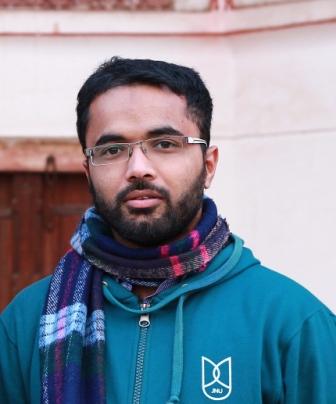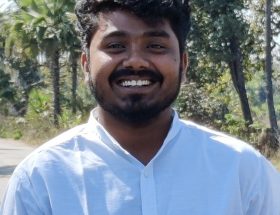C Ahamed Fayiz
 “It is your claim to equality which hurts them. They want to maintain the status quo. If you maintain your lowly status ungrudgingly, continue to remain dirty, filthy, backward, ignorant, poor and disunited, they will allow you to live in peace. The moment you start raising your level, the conflict starts”. ~ Dr B. R Ambedkar
“It is your claim to equality which hurts them. They want to maintain the status quo. If you maintain your lowly status ungrudgingly, continue to remain dirty, filthy, backward, ignorant, poor and disunited, they will allow you to live in peace. The moment you start raising your level, the conflict starts”. ~ Dr B. R Ambedkar
After the alliance of the left parties AISA and SFI in the campus swept all four seats in its students’ union (JNUSU) elections, reports and analysis are coming out on the victory of the left over ABVP and in another sense victory of Marxism over Hindutva. In a move that was seen as an ‘ideological compromise’, Communist Party of India (Marxist) affiliated Students’ Federation of India (SFI) and All India Students’ Association (AISA), the student wing of the Communist Party of India (Marxist-Leninist), decided to form a ‘united front’ to fight the JNUSU elections this time.
The alliance won all the four posts that include president, vice president, general secretary and joint secretary of JNUSU while the two year old Birsa Ambedkar Phule Students Association (BAPSA) challenged the hegemonic politics of both left and right wing students organisations in the campus through a close fight. For the post of president Rahul Sonpimple of BAPSA gained 1545 votes and lost against AISA–SFI alliance by a margin of just 409 votes. Mohit from AISA has been declared the president having secured 1954 votes. Akhil Bharatiya Vidyarthi Parishad (ABVP) which after the gap of 14 years, in 2015, managed to win one out of the four posts, was completely decimated this year. It even lost all seats of councilors. However final results show the strong support ABVP has managed to garner in the campus which cannot be underestimated. Had it not been for the left alliance they would have managed to secure at least two posts in the central panel who finished second for the post of vice president and general secretary.
Rahul of BAPSA who contested for the post of president and Pratim of DSF who contested for the post of the joint secretary emerged as the formidable opponents. Pratim was bested by Tabrez from AISA by a difference of some 436 votes. In spite of being left out from the left alliance DSF made its mark securing 1234 votes. SFI got 2 central panel seats after a long time and clearly benefitted from the left alliance. Amal was elected for the post of vice president and Satarupa for the post of general secretary, both winning by a margin of more than 1000 votes. At the same time, it is quite interesting to note that Mohit and Tabrez who were the candidates of AISA in the Left Alliance won with a low margin as compared to SFI candidates, which clearly shows that the left leaning votes has gone to BAPSA candidates. It also indicates that the left unity against the fascist regime is a myth as the concerned parties (especially the voting pattern indicates that AISA candidates didn’t get SFI cadre vote) couldn’t confirm their own vote to their candidates. We can hope there won’t be two JNUSU’s in the coming days: JNUSU AISA & JNUSU SFI (like last year’s JNUSU ABVP). However, the turnout for the 2016 election was 58% which is slightly better than the last year’s 53%.
The contours of the electoral battle in the JNU student union elections became evident after 9 February incident which led to the arrest of former JNUSU president Kanhaiya Kumar on sedition charges. What followed was a month long protest that rocked the campus. JNU hit the headlines and a fierce debate on ‘nationalism’ and sedition law ensued.
Following the 9 February incident when allegedly anti-national slogans were raised by some students in the JNU campus, two hashtags evidently polarised the political discourse in the campus. The divide however was not limited to the campus. Entire nation seems to have jumped on the political bandwagon. From autorickshaw drivers to ‘newsrooms intellectuals’ were seen, sharing and supporting, one of the two hashtags that was: #StandWithJNU or #ShutDownJNU. As expected, ABVP which was instrumental in exposing the ‘anti-national’ activities in the campus, went to the polls with their ‘save the JNU from anti-nationals’ rhetoric. Their appeal was to ‘defeat the anti-national, secessionist cartel’. On the other hand, the Left went with their appeal to preserve the ethos and culture of the JNU which is to ‘debate and dissent’.
Challenging these two hegemonic discourses, questioning the idea of JNU which is quite problematic, BAPSA has emerged as the third front in the campus raising the slogans of unity of oppressed i.e the unity of Dalit-Muslim-Adivasi Bahujan people. BAPSA had contested two seats of central panel last year in JNUSU elections and had gained around 350 votes for each seat. This time their vote increased to three to five times more compared to previous year which shows the emergence of Dalit-Bahujan politics in the left agrahara.
Mandal Commssion Report and the emergence of Dalit Muslim Bahujan politics
The rise of Dalit-Bahujan politics is a trend in the central universities of the country in the post-Mandal period. Hyderabad Central University, EFLU, Osmania University, Pondicherry University etc are some of the evidence of the success of such politics both in academic field and electoral politics. Students from the oppressed communities started to join in these universities in large number after the implementation of Mandal Commission recommendations in 2006. Earlier, where the left academicians and left student organisations who neglected Ambedkar and Ambedkarite politics have now started to write essays about the need of Dalit-Left unity. Left organisations, irrespective of their several factions, began to raise the slogan Jai Bhim Lal Salam in and outside the campus, which shows the ideological victory of Ambedkarite politics.
After the institutionalized murder of Rohith Vemula, every left party in JNU tried to appropriate the agency of Dalits, which was seriously challenged by BAPSA in the campus. On December 6th last year, BAPSA, along with Students Islamic Organisation (SIO), Youth Forum for Discussion and Welfare Activities (YFDA), Jharkhand Tribal Students Association (JTSA) conducted oppressed unity march in memory of Babri Masjid demolition and Dr. Ambedkar’s Samadhi day. The slogan raised during the march was “Nahi sahenge Hamirpur, Nahi Sahenge Dadri, Phir Banao Phir Banao Phir banao Babri” (We will not tolerate Hamirpur, we will not tolerate Dadri, rebuild Babri, rebuild Babri). The left organizations conducted a separate rally on the same issue, pointing out that they have different positions on the issue of rebuilding Babri Masjid. There was also united march commemorating Periyar, Ambedkar Jayanti etc which showed the the strength of BAPSA in which students joined the march in large numbers.
BAPSA has been actively involved in pointing out the issues of reservation, deprivation points in entrance exams of JNU to Dalits and Muslims. It also found out the absence of OBC teachers in the faculty of JNU. It is to be noted that, no candidate of left parties spoke a single word about the issue of deprivation points to Muslims in JNU entrances during presidential debates this year. Rahul Sonpimple, BAPSA candidate for the presidential post, pointed out the issue during the presidential debate: “Let me tell you that if the Minority Deprivation point is not allotted, then I promise that all 4 Gates of this campus will be closed. This is a promise from an oppressed to another oppressed. It is well known that the SC/ST/OBC/Minorities only get 0-3 marks in Viva Voce. I want to know those people who get 15-20 marks in viva-voce, which river’s water do they drink, which flour mill’s flour do they eat? JNU will only become progressive if the person who comes here from extreme poverty and difficult circumstances, gets admission, it will become progressive only when we follow our duty to let him/her respectfully be able to complete his/her studies and complete his/her degree. But this doesn’t happen in this campus.”
AISA-SFI left alliance played the politics of fear pointing the bogey of ABVP which was sarcastically criticized by BAPSA candidate Rahul and later became a mass dialogue both in online and offline election campaign “These people say please don’t vote for BAPSA, otherwise ABVP will win. Similar to Gabbar will come. How long will Gabbar happen? I say this time Gabbar won’t come, Kabali will come”.
The support from the organisations from the marginalized communities like YFDA and SIO and the active involvement of BAPSA in both academic and popular discourses made undercurrents which reflected as votes for BAPSA in the election. Pallikonda Manikanta of BAPSA, who competed for the post General Secretary gained 856 votes, Bansidhar Deep gained 796 votes for vice president and Aarti gained 608 votes for Joint Secretary posts. We should also notice that one of the student organization of a prominent party in the Indian politics, ie NSUI couldn’t even get the votes gained by NOTA in central panel, which shows that BAPSA is emerging as the third front in the campus. It is to be added that the parent organization of NSUI, which once tried to refused to address the questions raised by Ambedkar, is also losing its relevance in Indian political scenario while we see the resurgence of Dalit- Muslim Bahujan organisations in the form of ASA in HCU, APSC in IIT Madras and now BAPSA in JNU.
It is very important to note that even the radical left persons, who were celebrated by the media as heroes, the self-proclaimed messiahs of Dalits and Muslims, who came to know about Dr. Ambedkar only after the institutional murder of Rohith Vemula and later started an organization in the campus, namely Bhagat Singh Ambedkar Students Organisation (BASO), too were actively involved in elections. They endorsed and encouraged students to vote for the AISA-SFI left alliance. A two year old Dalit-Bahujan party had shown their strength in electoral politics standing between two mighty hegemonic ideologies which share same ideology, but in two different styles. BAPSA has challenged a large left front (including radicals, liberals, mild and militant ones) who have the history of neglecting and ridiculing Dr. Ambedkar and who had deliberately tried to perish Dalit Bahujan politics both academically and physically, in several campuses throughout the country and at the same time state-supported ABVP has been threatened by BAPSA’s striking slogan, ‘Lal-Bhagva Ek Hai, Sare Comrades fake hai’ (Red and Saffron are the same, all comrades are fake), which gives a clear message to both.
The number of votes gained by BAPSA doesn’t matter, but ideologically they had won this battle. Reaching second place for the presidential position in JNUSU elections is a great leap for the upcoming politics of depressed and oppressed communities and nationalities. No one has spoken about Marx and class struggle during election campaign. Every party has used Ambekar’s and Phule’s photo. Every left party raises the slogan Jai Bhim Lal Salam nowadays in and outside the campus. The post-election analysis posted in Facebook by one of the prominent left women leaders in the campus accuses that BAPSA got the vote from ABVP for president’s seat. Here the words of Dr.Ambedkar quoted at the beginning of this article becomes relevant. The claim for equality has hurt them. Yes, The conflict has started.
~~~
C Ahamed Fayiz is from Mannarkkad of Palakkad district, Kerala. He completed his law graduation from Government Law College, Ernakulam, and is now doing P.G Diploma in Radio and TV Journalism at Indian Institute of Mass Communication, New Delhi.









